
Bukit Timah Nature Reserve (BTNR for short) is one of the 2 places left in Singapore that still consists of primary forest, albeit fragmented. But since my last visit to Taman Negara, I have been eager to venture into this forest which Seraya trees are capable of shooting up to 70 meters in height - even if it's just walking along the jogger's path. Since it was my virgin trip here, I had to leave the cosiness of my nest at half-past 6 (after all, getting lost is one of my forte.. lol). But even so, I wouldn't trade this day for any other thing in the world (or beyond it). =)
One of the plants that was introduced into my limited realm of flora information is none other than the petai.
One of the plants that was introduced into my limited realm of flora information is none other than the petai.
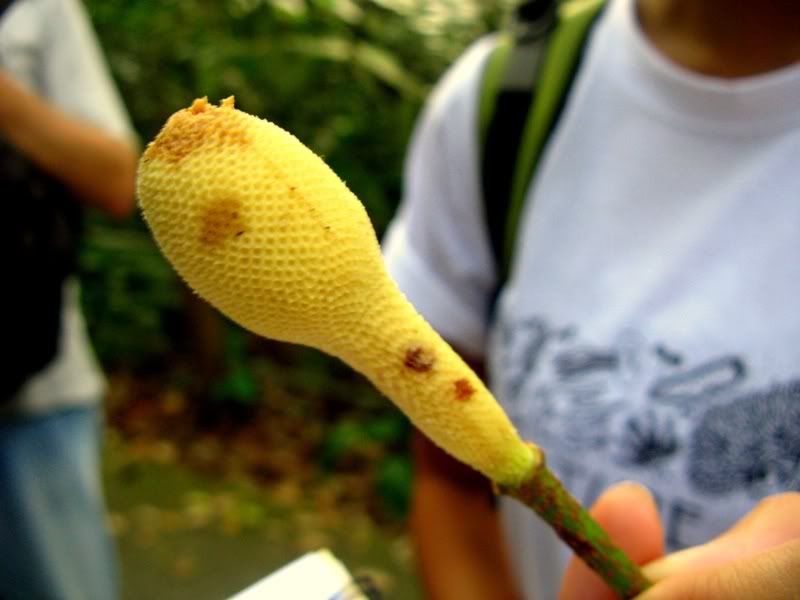 ___
___
(left): The young inflorescence of the Parkia speciosa or otherwise known as the petai. Doesn't this collection of flowers (aka inflorescence) resemble a microphone? ;) I was really surprise when LK informed us about the identity of the plant as I have never seen a petai flower even if the beans are used rather frequently in Malaysian dishes. Yeah, that's me, a well-inhabiting frog.. or rather a 井底之蛙. =)
(right): Curiously, the old inflorescence loses its slender form as it becomes older and turns rather stout and bulbous. To aid in their dispersal, the yellow blossoms secrete a nectar that attracts pollinators, especially bats. [1]
(right): Curiously, the old inflorescence loses its slender form as it becomes older and turns rather stout and bulbous. To aid in their dispersal, the yellow blossoms secrete a nectar that attracts pollinators, especially bats. [1]
 ___
___
(left): The leaves of the petai. At first glance, it looked to me like a fern as this plant also possesses pinnate leaves (= leaflets which are arranged on each side of a common stalk).
(right): This plant species can generally reach 30 metres in height [1]. Sunlight-loving, this species is one of the first species to pioneer a land which opens up to a gap in a primary forest. Gaps often occur in virgin, primary forests when trees fall due to either old age, etc. And in situations where colonization of a land is involved, pioneer species are mostly secondary species. Besides the gap, the Parkia speciosa can also be found at the edge of the forest where sunlight is abundant.
(right): This plant species can generally reach 30 metres in height [1]. Sunlight-loving, this species is one of the first species to pioneer a land which opens up to a gap in a primary forest. Gaps often occur in virgin, primary forests when trees fall due to either old age, etc. And in situations where colonization of a land is involved, pioneer species are mostly secondary species. Besides the gap, the Parkia speciosa can also be found at the edge of the forest where sunlight is abundant.
 ___
___
(left): Archidendron sp. was the 2nd plant we saw that belonged to the same family (Fabaceae) as the petai. One unique characteristic of this tree is that the leaves it bear are of a rhomboid shape. And generally, the leaves of the Fabaceae family are compound.
(right): Here's a plant from a different family (Anisophylleaceae) that also possesses distinctive rhomboid-shaped leaves - the mousedeer plant (Anisophyllea distichia). So called because the fruits from this forest shrub is thought to be dispersed by mousedeer [9]. All this talk about rhombus makes me wanna eat kuih lapis. =)
(right): Here's a plant from a different family (Anisophylleaceae) that also possesses distinctive rhomboid-shaped leaves - the mousedeer plant (Anisophyllea distichia). So called because the fruits from this forest shrub is thought to be dispersed by mousedeer [9]. All this talk about rhombus makes me wanna eat kuih lapis. =)
 ___
___
(left): The 3rd Fabaceae plant that LK introduced to us guides was the butterfly vine (Bauhinia semibifida). But unlike the petai and the Archidendron sp. (both belongs to the subfamily Mimosoideae), this Bauhinia sp. belongs to the subfamily Caesalpiniaceae. Apparently this tendriled climber is the only native bauhinia in Singapore [13]. Sweet!
(right): An attempt to shoot the stipules of the bauhinia. It's said that the flowers (white when young, yellow when old) has a musky-sweet scent. But no flowers were spotted. Well, that's that I guess. >__>
(right): An attempt to shoot the stipules of the bauhinia. It's said that the flowers (white when young, yellow when old) has a musky-sweet scent. But no flowers were spotted. Well, that's that I guess. >__>
 ___
___
(left): Another sun-loving species that can also be found at brighter places like that of a gap in the forest is the Terentang (Campnosperma sp.). This pioneer plant species is hence, a good indicator of a secondary forest, which is comprised of "vegetation that has re-grown after the destruction of the primary vegetation either naturally or via human impacts" [2]. One adorable form of the plant is the ear-like structure that can be found at the base of its leaf. :)
(right): Another snapshot of the ear-like base, but this time on a real live specimen. ^^ One other interesting fact is that the wood of the plant is soft enough to be made into stuff like match boxes, disposable chopsticks, ice-cream stick, tongue-pressers etc [12]. Who would have thought?
(right): Another snapshot of the ear-like base, but this time on a real live specimen. ^^ One other interesting fact is that the wood of the plant is soft enough to be made into stuff like match boxes, disposable chopsticks, ice-cream stick, tongue-pressers etc [12]. Who would have thought?
 ___
___
(left): If my memory (and my notebook) served me right, this plant belongs to a primary vegetation from the genus Canarium.
(right): The furled leaf of the Canarium sp. ... though it's pinkish-red in hue, it should not be confused as a flower bud (like yours truly did). .___.
(right): The furled leaf of the Canarium sp. ... though it's pinkish-red in hue, it should not be confused as a flower bud (like yours truly did). .___.
 ___
___
(left): Big as it might seem, this leaf with a spinose margin (= the jagged tooth of the vein that extends beyond the leaf edge) is a compound leaf (= a leaflet that's part of one big leaf). Its fruit is a drupe with a sharp, hard and stony seed.
(right): An eye-level of the hairs that can be found on the leaf. The Canarium sp. is a true primary forest species that can be found at the layer where shrubs/treelets reside. There are, in fact, altogether 5 layers (or strata) to a primary forest canopy. The highest layer is the emergent layer followed by the main canopy, the sub-canopy layer, the shrub/treelet layer and finally, the forest floor herb/seedling layer.
(right): An eye-level of the hairs that can be found on the leaf. The Canarium sp. is a true primary forest species that can be found at the layer where shrubs/treelets reside. There are, in fact, altogether 5 layers (or strata) to a primary forest canopy. The highest layer is the emergent layer followed by the main canopy, the sub-canopy layer, the shrub/treelet layer and finally, the forest floor herb/seedling layer.
 ___
___
The liana, a hard and woody climber, was another interesting species which we became acquainted with. These 'curly fries' and 'corkscrew' look-alikes entwine around other plants to reach the surface, where it's well-lit with sunlight. One of its ecological importance is that the plant - akin to an airborne bridge - provides a route for animals like squirrels, ants and other insects etc to travel from one place to another without going down to the forest floor.
 ___
___
However, let's not get confused between a climber and a creeper. A climber (left) is able to reach to the surface of the canopy without needing any support from other plants while creepers (right) behave otherwise. But, there's only 1 aim for forest plants to go up so high, and that's to get sufficient sunlight for photosynthesis. :)
 ___
___
(left): LK explained that the area used to be an experimental plot for the planting of Gutta percha. However, that happened about [Edit] 1 century ago. This also means one thing, this area can no longer be called a primary forest as the word is specific for "vegetation in which continuity with the primeval vegetation has never been broken by clearance" [2].
(right): Joggers heading down the pathway leading to the Taban Valley. In fact, it's along these slopes, a [Edit] Palaquium gutta plantation was started in 1819 for the harvesting of the Gutta's sap.
(right): Joggers heading down the pathway leading to the Taban Valley. In fact, it's along these slopes, a [Edit] Palaquium gutta plantation was started in 1819 for the harvesting of the Gutta's sap.
 ___
___
(left): And speak of the 'devil', we spotted some of the plantation's remnants scattered about in the nature reserve. Here's a tree of the P. gutta plant which plantation once covered 16 hectares (160,000 square meters) of the reserve in 1910.
(right): One distinguishable of the Palaquium gutta is that the underside of the leaves are somewhere between gold and bronze. Before rubber reached this island, H.N Ridley (founder and director of Botanic Gardens) discovered that the P. gutta has a lot of latex. Its latex was then heavily used in World War I to build submarine cables for the transmission of messages.
(right): One distinguishable of the Palaquium gutta is that the underside of the leaves are somewhere between gold and bronze. Before rubber reached this island, H.N Ridley (founder and director of Botanic Gardens) discovered that the P. gutta has a lot of latex. Its latex was then heavily used in World War I to build submarine cables for the transmission of messages.
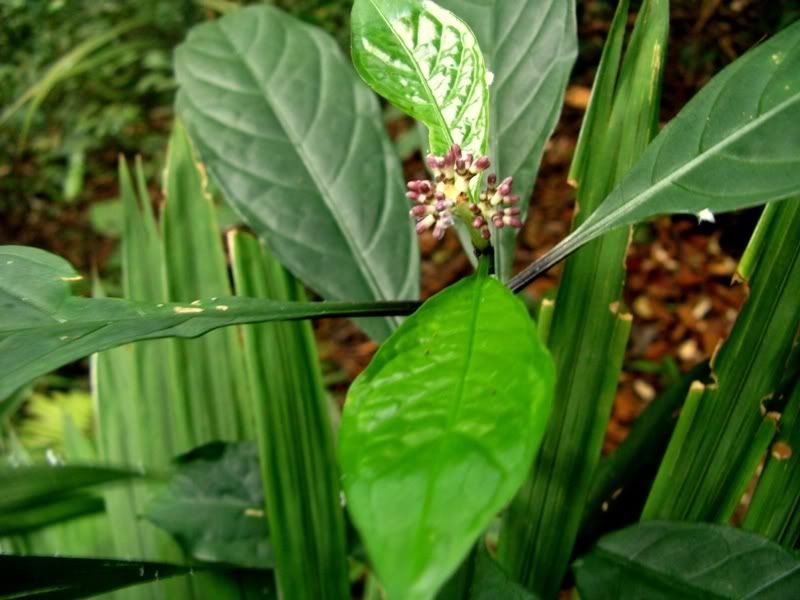 ___
___
And here we have the beras-beras [Edit] (Chasalia sp.) plant which has its blackberry-like fruit dispersed by birds. The inflorescence looks really sweet with a tinge of purple at the tip and creamy white at its bottom. When unripe, the fruit takes a red coloration.
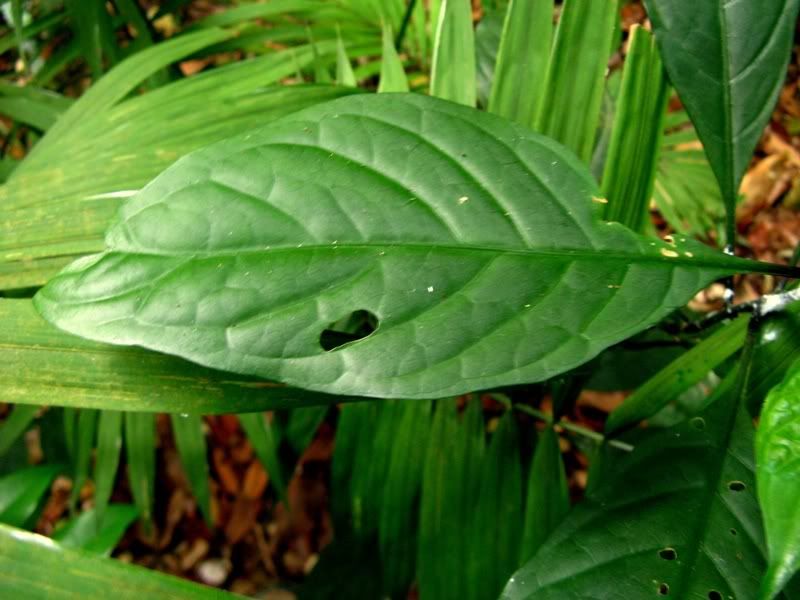 ___
___
On the left shows the top-side of the leaf while the right captures the underside. And judging from the holes on the beras-beras's leaf, it seems that the plant had experienced some herbivory (= the feeding of plants without killing them [3]).
 ___
___
*Do pardon the blurred outlines in the pictures*
(left): More signs of herbivory. The symmetrical shapes on the semi-eaten leaves are obtained by having them chewed/chomped on when they are still folded.
(right): A plant from the Family Rhizophoraceae (Lat: bearer of roots [4]). The prop roots are characteristics of the genus Rhizophora as they provide support on unstable strata such as muddy or water-logged areas. After some googling, it seems that not all Rhizophoraceae vegetation have props roots. One example is that the Bruguiera spp. also belong to this particular Family, but they possess kneed roots instead of prop ones.
(left): More signs of herbivory. The symmetrical shapes on the semi-eaten leaves are obtained by having them chewed/chomped on when they are still folded.
(right): A plant from the Family Rhizophoraceae (Lat: bearer of roots [4]). The prop roots are characteristics of the genus Rhizophora as they provide support on unstable strata such as muddy or water-logged areas. After some googling, it seems that not all Rhizophoraceae vegetation have props roots. One example is that the Bruguiera spp. also belong to this particular Family, but they possess kneed roots instead of prop ones.
 ___
___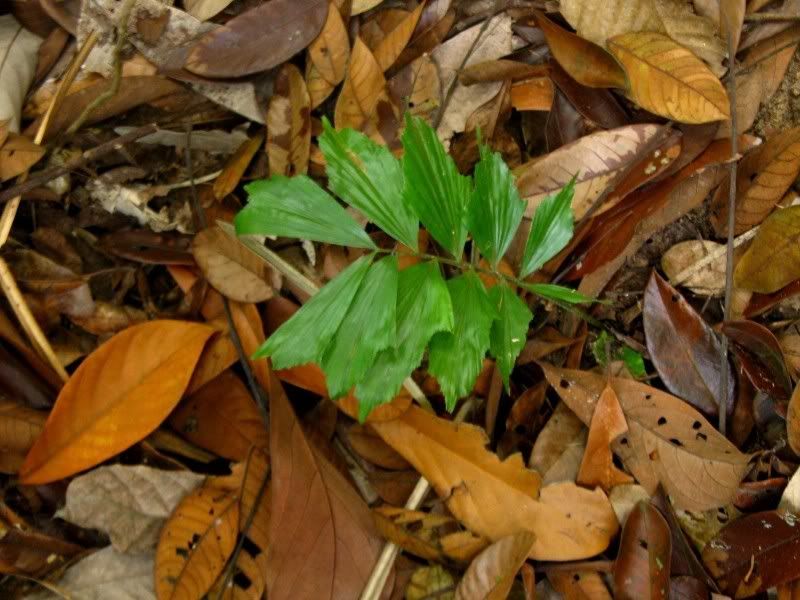
(left): The Licuala palm (Licuala ferruginea) is one palm that we saw on our slow trek along the leaf-scattered path. These Palmae make popular aesthetic plants for gardens and indoor decorations. But, it's without a doubt, that these plants are in their best form when in the wild. =)
(right): The fishtail palm (Caryota mitis) has its common name derived from the shape of its leaflets (probably resembling the tail of a goldfish? ^^). It's a good indicator of secondary forests since it is a common native palm of such a habitat. The roundish, red berries (when ripe) are eaten by birds and then dispersed. And just like other palm, it has sap which can be tapped to be made into palm sugar or fermented to produce toddy [5].
(right): The fishtail palm (Caryota mitis) has its common name derived from the shape of its leaflets (probably resembling the tail of a goldfish? ^^). It's a good indicator of secondary forests since it is a common native palm of such a habitat. The roundish, red berries (when ripe) are eaten by birds and then dispersed. And just like other palm, it has sap which can be tapped to be made into palm sugar or fermented to produce toddy [5].
 ___
___
(left): The fronds of a forest coconut which is neither a coconut nor a palm (even though its leaves resemble one).
(right): And one distinctive feature of the plant is the yellow flower that can be found growing at the base of the plant. Its fruit tastes sweet and whatever that's eaten with it will also taste sweet. Just my kind of fruit indeed! ;)
(right): And one distinctive feature of the plant is the yellow flower that can be found growing at the base of the plant. Its fruit tastes sweet and whatever that's eaten with it will also taste sweet. Just my kind of fruit indeed! ;)
 ___
___
(left): The Rengas tree (the one slanting sidewards in the pic) is not a plant that you want to mess with, trust me. Initially, I thought that the tree is just liable for some allergic reactions to a few sensitive ones... until I googled it. And O-M-G, the tree actually contains poisonous resinous sap that can cause mild itching of the skin for some while to others, it will cause painful blisters and form open sores which heal very slowly. It is unwise even to shelter beneath the trees because raindrops will carry down the poison from the leaves or broken branches [6]. One way to recognize the plant is to take notice of any black stains on the surface of the trunk and branches. Apparently, the sap turns black once exposed to air [7]. *shudders*
(right): Speaking of black (but on a much lighter note), here's a plant that yields gorgeous dark maroon blooms - the Bat Lily (Tacca integrifolia).
(right): Speaking of black (but on a much lighter note), here's a plant that yields gorgeous dark maroon blooms - the Bat Lily (Tacca integrifolia).
 ___
___
(left): Presenting the flower bud of the T. integrifolia.
(right): After a few days, the Bat Lily's bud will slowly unfurl and lily-like tendrils can be seen spilling from the bud's edges.
(right): After a few days, the Bat Lily's bud will slowly unfurl and lily-like tendrils can be seen spilling from the bud's edges.
 ___
___
(left): And with just enough shade and suitable environmental conditions, the bud continues to unfurl to produce blooms that look elegant and gorgeous.
(right): After pollination (or even when conditions start to decline), the blooms start to wither and fade, rendering a once spectacular sight to just a shadow of its former glory. However, we noticed that there were quite a lot of buds and midway-opened ones on our little trip, and it's presumed that they will be mass flowering come a few days time. Gosh wouldn't it be superb if you could be there when that occurs? =)
(right): After pollination (or even when conditions start to decline), the blooms start to wither and fade, rendering a once spectacular sight to just a shadow of its former glory. However, we noticed that there were quite a lot of buds and midway-opened ones on our little trip, and it's presumed that they will be mass flowering come a few days time. Gosh wouldn't it be superb if you could be there when that occurs? =)
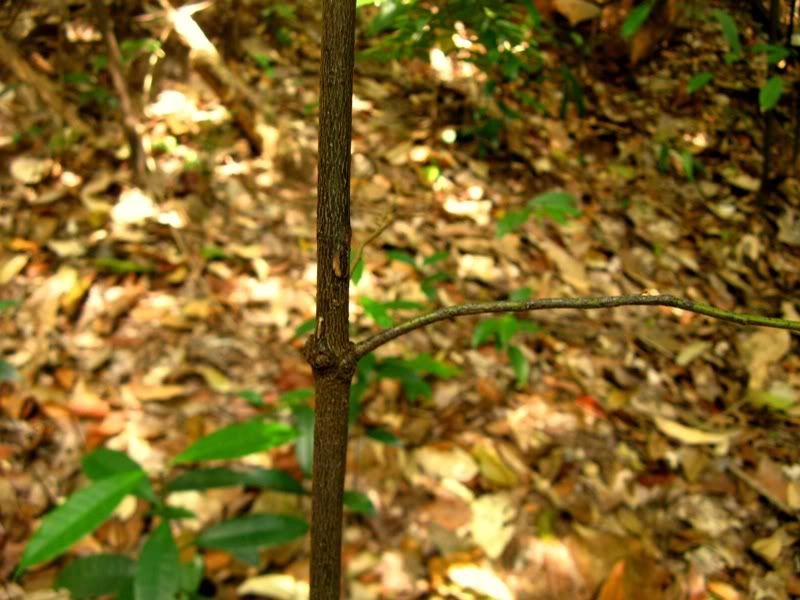 ___
___
(left): One other plant that shares a "dark" similarity with the above 2 is the ebony [Edit] (Diospyros buxifolia) that fetches a rather high price in the market as an ornamental wood. Why so? That's because the timber of most ebony species is intensely black. Coupled with its fine texture and ability to be polished smoothly, I am not surprised if such wood are being illegally logged to be sold in the black market [14].
(right): The alternate leaves of the juvenile ebony plant.
(right): The alternate leaves of the juvenile ebony plant.
 ___
___
(left): A close-up on a cauliflory (Lat: stem-flower) structure. This structure basically means the production of flowers and fruits directly from the trunks of woody/tropical plants (instead of the usual flowering and fruiting from new growth or young, leafy stems [8]). This feature is only unique to plants inhabiting the tropical rain forest (and not temperate countries).
(right): The male flowers of the Baccaurea parviflora exhibiting the cauliflory characteristic. For the males, the flowers can be found growing around the trunk of the tree.
(right): The male flowers of the Baccaurea parviflora exhibiting the cauliflory characteristic. For the males, the flowers can be found growing around the trunk of the tree.
 ___
___
(left): Unlike the males, the white female B. parviflora flowers can mostly be found growing in clusters at the base of the plant's dark, fissured trunk. This plant, though unique to the tropical rainforest, is one of the top 10 most abundant plants in the nature reserve. Once the flowers have been pollinated, they will yield fruits of a reddish-black colour. Unfortunately, we didn't get to see them though. :(
(right): A close-up on the flowers. This evolutionary adaptation is hypothetically thought to allow mammalians to feed on the flowers without having to climb up high onto the tree. The plant is also dioecious, hence only female flowers can be found on one tree, while their 'co-partners' can be found on a different tree altogether. =)
(right): A close-up on the flowers. This evolutionary adaptation is hypothetically thought to allow mammalians to feed on the flowers without having to climb up high onto the tree. The plant is also dioecious, hence only female flowers can be found on one tree, while their 'co-partners' can be found on a different tree altogether. =)
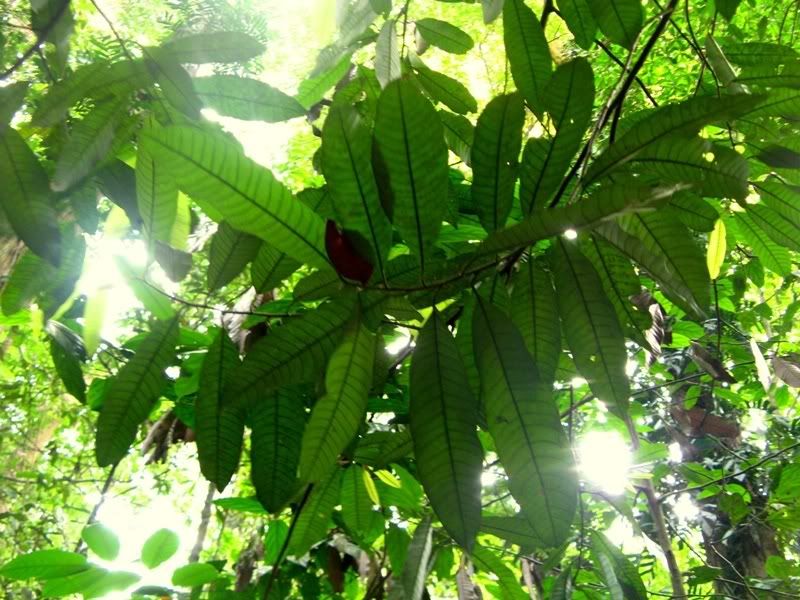 ___
___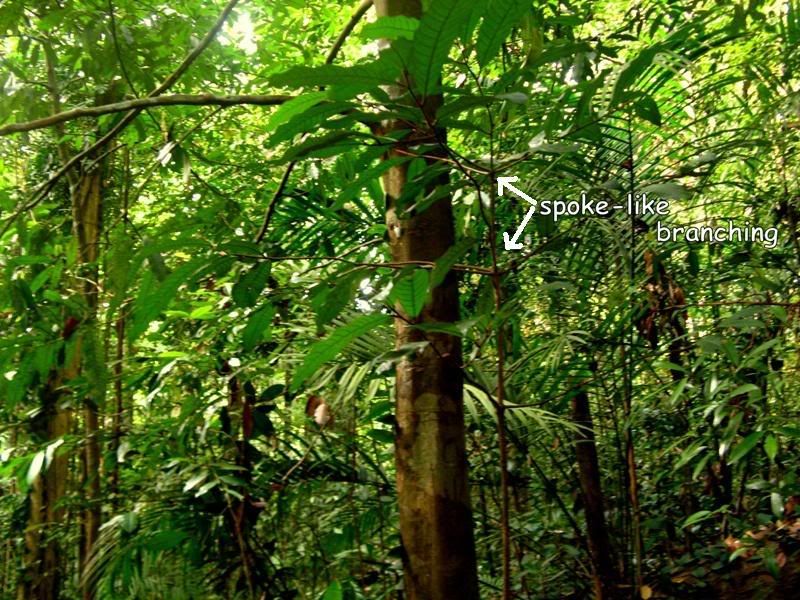
(left): The leaves of a nutmeg plant. Generally, the seeds of nutmegs are dispersed by birds. In fact, it seems that nutmegs that get dispersed by our feathered friends stand a better chance in germinating compared to nutmegs that just drop from the tree (and sometimes even better than the ones that are hand-grown). Apparently, when birds eat the nutmeg, they digest the red astringent mace that covers the seed when it passes through their guts. The lacy-like covering isn't removed if the fruit just falls off from the parent plant and left to grow. Sadly, the nutmegs of the BTNR are suffering and declining as their main dispersal agent (the birds) are lacking in the forest.
(right): One way to recognize the nutmeg tree is by its spokes-like branching that grows from the main trunk. And yes, the skinny plant in the picture is the nutmeg tree (and not the one behind it). =)
(right): One way to recognize the nutmeg tree is by its spokes-like branching that grows from the main trunk. And yes, the skinny plant in the picture is the nutmeg tree (and not the one behind it). =)
 ___
___
(left): Another kind of branching that we witnessed was the right-angle branching exhibited by a plant from the Rubiaceae family (aka the coffee family). Look closely and you will notice the branches that stem out from the main trunk are at a 90 degrees from each other. ^^ This unique branching allows leaves to get maximum sunlight in a sheltered area. 2 other ways to distinguish the flora from the Rubiaceae family is that they have (1) opposite leaves and (2) interpetiolar stipules (= stipules are found growing between the petiole/leafstalk) [10] .
(right): And from the silver timon (another member of the Rubiaceae), its twisted bud can be seen growing between 2 opposite leaves.
(right): And from the silver timon (another member of the Rubiaceae), its twisted bud can be seen growing between 2 opposite leaves.
 ___
___
(left): The silver timon (Timonius wallichianus) is so called because of the silvery sheen that can be found shimmering at the top side of the leaf (and at the underside too if I am not mistaken). :)
(right): The underside of the silver timon, that's completely covered by silvery appressed hairs [11].
(right): The underside of the silver timon, that's completely covered by silvery appressed hairs [11].
 ___
___
(left): A fine venation is one of the distinctive features to the thick beauty leaf, Bintangor [Edit] (Calophyllum sp.). In Borneo, related species of this plant has been found to contain anti-AIDS properties. Of course, further research is being conducted to ascertain the fact.
(right): The rust-hued, hairy bud from a different Calophyllum sp. - the C. ferrugineum (Lat: rust-colored). Once you understand the Latin for the generic name (genus) or specific epithet (species), it's really easy to remember the scientific names of the organisms; be it plants, animals or microorganisms. :)
(right): The rust-hued, hairy bud from a different Calophyllum sp. - the C. ferrugineum (Lat: rust-colored). Once you understand the Latin for the generic name (genus) or specific epithet (species), it's really easy to remember the scientific names of the organisms; be it plants, animals or microorganisms. :)
 ___
___
(left): Another plant with thick and waxy leaves that have no distinct venation is a species from the genus Memecylon.
(right): Other characteristics of the plant is that the leaves are found growing opposite each other. Not only is it found in the forest, this plant can also be found inhabiting coastal areas.
(right): Other characteristics of the plant is that the leaves are found growing opposite each other. Not only is it found in the forest, this plant can also be found inhabiting coastal areas.
 ___
___
(left): One plant that shares the same characteristic - flattened bud - with the Scyphiphora sp. and the Ceriops sp. is the [Edit] Nauclea sp. Instead of just taking a snapshot of its distinctive feature, I should have also taken a picture of the leaf arrangement, the tree etc. A little kiasu-ism would be better than coming back and then to sigh with regret over the lack of information. Noted!
(right): The leaf of the Nauclea sp. which is rather large in size. Lol, that reminds me, I will also need to get the book "Trees of Bukit Timah". =)
(right): The leaf of the Nauclea sp. which is rather large in size. Lol, that reminds me, I will also need to get the book "Trees of Bukit Timah". =)
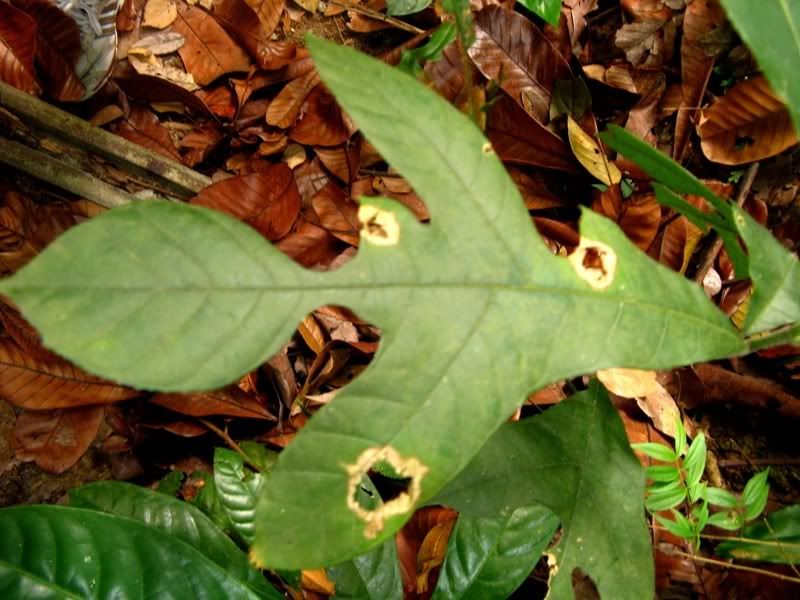 ___
___
(left): Presenting a genus from the fig family (Moraceae), the Artocarpus sp.. These genus is the one that gives us our breadfruit, jackfruit and cempedak. In fact the name 'Artocarpus' is derived from the Greek words 'artos' ( = bread) and 'karpos' ( = fruit). So called because when cooked, the taste is described as potato-like, or similar to fresh baked bread. Here we have the juvenile leaf which has a relatively larger surface area compared to the adult leaf, hence enabling it to receive more sunlight for photosynthesis.
(right): Here's a snapshot of the adult leaf which clearly adopts a different form from its juvenile phase.
(right): Here's a snapshot of the adult leaf which clearly adopts a different form from its juvenile phase.
 ___
___
(left): The Tempines [Edit] (Streblus elongatus) is another plant that comes from the Moraceae family @ the fig family). And to tell if it's from this particular family is to distinguish its 3 unique characteristics: (1) prescence of stipules, (2) prescence of intrapetiolar scars and (3) presence of sap when leaf/stem is broken. And hey presto, you have identified the Moraceae. =)
(right): One unique feature of the Tempines tree is that the plant has an obvious unequal or asymmetrical leaf base.
(right): One unique feature of the Tempines tree is that the plant has an obvious unequal or asymmetrical leaf base.
 ___
___
(left): Another view of the asymmetrical leaf base of the Tampines leaf.
(right): The 3rd Moraceae plant that I noted was from the genus Ficus. If my ears heard right, the specific epithet of this plant was said to be derived from its arrow-like leaf. After surfing through the internet, the fig which name fits the bill is the Ficus sagittifolia, in which the word 'sagittifolia' originates from the Latin words 'sagitta' (= arrow) and 'folium' (= leaf), which in short means 'arrow-leaf'. But then again, I could be mistaken.
(right): The 3rd Moraceae plant that I noted was from the genus Ficus. If my ears heard right, the specific epithet of this plant was said to be derived from its arrow-like leaf. After surfing through the internet, the fig which name fits the bill is the Ficus sagittifolia, in which the word 'sagittifolia' originates from the Latin words 'sagitta' (= arrow) and 'folium' (= leaf), which in short means 'arrow-leaf'. But then again, I could be mistaken.
 ___
___
(left): Although it's not used as frequently as the 3 aforementioned characteristics, the 3 sharp angles at the base of the underside of the leaf can possibly tell apart species from the [Edit] genus Ficus from the other members of the Moraceae family.
(right): Shapes can sometimes be a big give-away to the identity of certain plants. For example, the crescent tree (Aporosa benthamiana) has stipules that are distinctively crescent-shaped.
(right): Shapes can sometimes be a big give-away to the identity of certain plants. For example, the crescent tree (Aporosa benthamiana) has stipules that are distinctively crescent-shaped.
 ___
___
(left): At first glance, the leaf shape brought to mind a tapioca plant. But after a closer look (and some clarification from LK), this plant is none other than the Ch'ng Teng (清汤) plant which gives us the jelly-like edibles in that particular dessert. The seed turns jelly-like when it gets exposed to water. I can't imagine what happens when it rains. All that squishy and gooey feel...
(right): Besides shapes, leaves arrangement can sometimes give the game away. Like the leaf litter plant, the rosette arrangement of leaves makes it stand out among other vegetation. Of course, this special pattern serves to benefit the plant by collecting dead leaves and rainwater that fall from above. The amount of nutrient it receives compensates for the lack of sunlight it gets in a well-canopied forest. Subsequently, the growth of the plant is slowed down and therefore, this species doesn't grow much taller than 3-4 meters.
(right): Besides shapes, leaves arrangement can sometimes give the game away. Like the leaf litter plant, the rosette arrangement of leaves makes it stand out among other vegetation. Of course, this special pattern serves to benefit the plant by collecting dead leaves and rainwater that fall from above. The amount of nutrient it receives compensates for the lack of sunlight it gets in a well-canopied forest. Subsequently, the growth of the plant is slowed down and therefore, this species doesn't grow much taller than 3-4 meters.
 ___
___
(left): Leaves arrangement otherwise, leaf venation can also offer clues that can lead to the revelation of the plant's identity. Like in the case of this Syzygium sp., 2 distinguishing features of the plant are 1) the presence of an intermarginal vein (= veins that run closely along the margin/edge of the leaf blade) and...
(right): 2) the arrangement of leaves that are directly opposite each other.
(right): 2) the arrangement of leaves that are directly opposite each other.
 ___
___
(left): A linear alignment of the reddish-brown stipules of the Macaranga bancana. This plant shares a symbiotic relationship (win-win relationship) with ants that reside in the hollow of the their stems.
(right): The macaranga produces these globules [Edit] (aka Beccarian bodies which are lipid-rich) within the stipules for the ants to feed on. And in return, the ants protect the plant from being eaten by herbivores and from the risk of getting hooked by other plants.
(right): The macaranga produces these globules [Edit] (aka Beccarian bodies which are lipid-rich) within the stipules for the ants to feed on. And in return, the ants protect the plant from being eaten by herbivores and from the risk of getting hooked by other plants.
 ___
___
(left): Of course, the forest isn't just limited to species of short statures. The Red Dhupe (Parishia insignis) is a heritage tree that stands tall and proud on the steep slopes of the Bukit Timah Nature Reserve. Heritage trees are awarded to certain giants by the National Parks of Singapore in an effort to conserve the huge and mature species of the nature reserve. However, there are certain criteria that needs to be fulfilled before a tree can be chosen as a heritage tree.
(right): The huge buttress roots of the Red Dhupe provides support on sloping ground. One side of the root leans a certain way to prevent the plant from falling.
(right): The huge buttress roots of the Red Dhupe provides support on sloping ground. One side of the root leans a certain way to prevent the plant from falling.
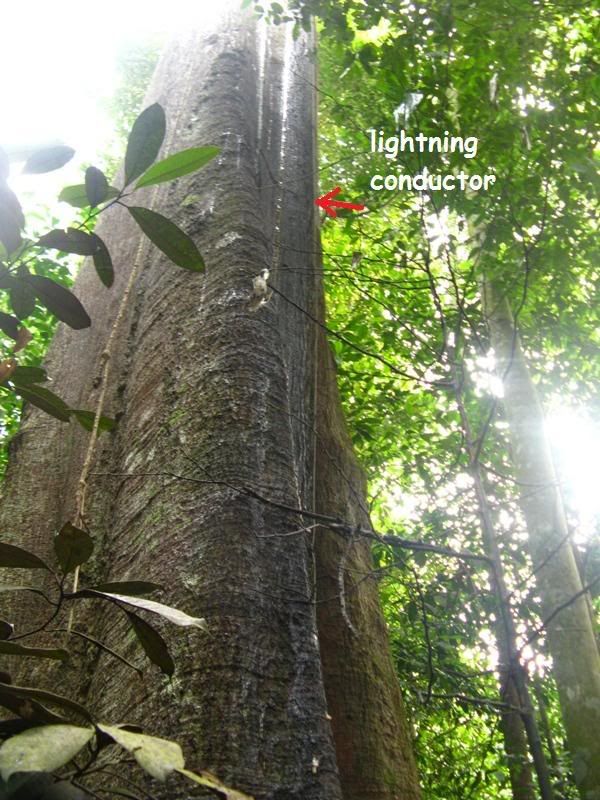 ___
___
(left): Ever since it was chosen as a Heritage tree, the P. insignis has been strung with a lightning conductor to protect it from being struck dead by lightning. In fact, all Heritage trees are armed with such protection as Singapore is said to experience the most lightning strikes in the world. Apparently, many tall trees in the nature reserve have been struck by lightning. One reason for this occurrence is due to the fragmentation of primary forest in the reserve. Primary forest, as you know, have 5 distinct layers to their canopy with the top most conquered by emerging giants. Since these giants are scattered about in the nature reserve, the chances of them getting struck by lightning is higher compared to if the nature reserve was made up entirely of primary forest.
(right): Another giant of the forest is the Petaling (Ochanostachys amentacea). Shallow depressions are often found on the surface of the trunk after the dead bark is shed. It's a famous timber tree which yields durable wood that are used as poles in construction. One interesting fact: the tree lends its name to KL's Petaling Jaya. :)
(right): Another giant of the forest is the Petaling (Ochanostachys amentacea). Shallow depressions are often found on the surface of the trunk after the dead bark is shed. It's a famous timber tree which yields durable wood that are used as poles in construction. One interesting fact: the tree lends its name to KL's Petaling Jaya. :)
There were altogether 2 Shorea spp. which we were introduced to during our 5-hour long trek through the nature reserve:
(1) Shorea leprosula [Edit]
(2) Shorea curtisii
Besides that, we also made acquaintance with another majestic giant - the Keruing [Edit] (Dipterocarpus caudatus). All these 3 belong to the same family - Dipterocarpaceae.
(1) Shorea leprosula [Edit]
(2) Shorea curtisii
Besides that, we also made acquaintance with another majestic giant - the Keruing [Edit] (Dipterocarpus caudatus). All these 3 belong to the same family - Dipterocarpaceae.
 ___
___
(left): The leaf of the S. leprosula (Lat: scale) has creamy white "scales" lining both sides of the primary leaf vein.
(right): For D. caudatus, the leaves have a wavy margin. However, characteristics are different for the S. curtisii as the leaves of this species have neither a wavy margin nor scale-like structures of the Keruing.
(right): For D. caudatus, the leaves have a wavy margin. However, characteristics are different for the S. curtisii as the leaves of this species have neither a wavy margin nor scale-like structures of the Keruing.
 ___
___
(left): But, one unique feature which all these 3 of the family Dipterocarpaceae share, is that their leaves have a swollen and twisted leaf base. On the leaf, the secondary vein is noted to lie at a 45 degree angle from the primary vein. This particular leaf belongs to the S. curtisii. Note the even margin and clean primary vein (no scale-like bits there).
(right): See that the leaf base of the D. caudatus is also slightly twisted and swollen? One other unique structure which is special to this species is its zig-zagging branches.
(right): See that the leaf base of the D. caudatus is also slightly twisted and swollen? One other unique structure which is special to this species is its zig-zagging branches.
 ___
___
(left): The stipule of the D. caudatus which is supposedly to be pink in colour. >_> I still can't understand why though.. it looks rather silverish-grey to me, and the tip is orange-y in hue. But then again, I did see more than one of these, and there were indeed some with a slight hint of pink. :)
(right): The pinwheel-akin blossom of the D. caudatus. Pretty... even though it's withered and slightly brown around the edges.
(right): The pinwheel-akin blossom of the D. caudatus. Pretty... even though it's withered and slightly brown around the edges.
 ___
___
The scaly tree trunk of the D. caudatus (left) versus the reddish-brown fissured trunk of the S. curtisii (right). These Dipterocarpaceae (unique to South East Asia) are found on the coastal hill dipterocarp forest of the Bukit Timah Nature Reserve, especially at grounds with higher elevation. It appears that there will be an occurrence of a masting in another couple of months. One cool fact about masting is that when a mass fruiting occurs in the forest of Singapore, the same phenomenon will also be occurring simultaneously around the entire South East Asia. This marvel is said to be only brought on after a long session of dry weather or drought. One hypothesis for such an occurrence is said to be due to predator satiation. A mass fruiting is said to reduce the number of seeds eaten by herbivores and thus, increase the germinating chances of species.
 ___
___
A dead S. curtisii that met its demise with a zap from Zeus' bolt. *o* The vegetative crown on the tree in the 2nd picture does not belong to the S. curtisii but to a climber species. Hence, the importance of a lightning conductor. *nods*
 ___
___
(left): A Keruing (D. caudatus) and a Bulmeodendron tokbrai side-by-side.
(right): One strange feature about this plant is that when the leaves wither and fall onto the ground, you will notice a prominent white edge show up on the leaf. But strangely, this does not occur when the leaf is still attached to the plant. So, it really does pay off to look at dead leaves too. :)
(right): One strange feature about this plant is that when the leaves wither and fall onto the ground, you will notice a prominent white edge show up on the leaf. But strangely, this does not occur when the leaf is still attached to the plant. So, it really does pay off to look at dead leaves too. :)
 ___
___
Big tree, small tree. But no matter which, we love you. =)
Besides flowering plants, we also saw ferns and fern allies. And with the information still fresh in my mind (as I just attended a Plant Diversity lab session the day before), I was able to savour every sorus and strobilus that we came upon. (okay, maybe not all.. :P)
Besides flowering plants, we also saw ferns and fern allies. And with the information still fresh in my mind (as I just attended a Plant Diversity lab session the day before), I was able to savour every sorus and strobilus that we came upon. (okay, maybe not all.. :P)
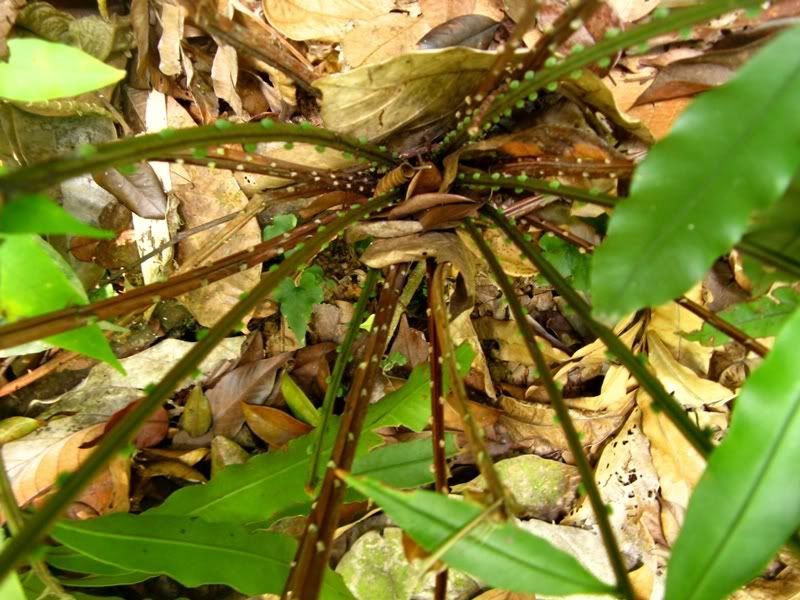 ___
___
(left): In this picture, we have the Centipede Fern. So called because during its juvenile phase, its young red stems and the row of knob-like leaflets resemble a centipede. Hmm... I guess it takes quite an imagination unless you have seen it firsthand.
(right): Since this fern was discovered in Singapore, it has a scientific name that bears tribute to its home - the Tectaria singaporeana. Commonly known as the Paku Biawak or Monitor Lizard Fern, this species is a nationally vulnerable plant found in the Bukit Timah and Central Catchment Nature Reserves.
(right): Since this fern was discovered in Singapore, it has a scientific name that bears tribute to its home - the Tectaria singaporeana. Commonly known as the Paku Biawak or Monitor Lizard Fern, this species is a nationally vulnerable plant found in the Bukit Timah and Central Catchment Nature Reserves.
 ___
___
(left): Ferns are different from fern allies in a sense that the spores of the ferns are kept in a sporangium. A cluster of the sporangia is also known as a sorus. So those little pore-like structures that bead the frond is actually a sorus each.
(right): However for fern allies (Selaginella sp. in this case), the spores are kept in either a microsporangium (male) or macrosporangium (female) that's enclosed within a microspore wall. All these structures are found in the candlestick-like strobilus that juts out from the end of each frond. Selaginella sp. is a fern ally that's heterospory, which means it harbors in its strobilus both male and female spores while other fern ally such as the Lycopodium sp. is a homospory. (= either male/female spore in a single strobilus)
(right): However for fern allies (Selaginella sp. in this case), the spores are kept in either a microsporangium (male) or macrosporangium (female) that's enclosed within a microspore wall. All these structures are found in the candlestick-like strobilus that juts out from the end of each frond. Selaginella sp. is a fern ally that's heterospory, which means it harbors in its strobilus both male and female spores while other fern ally such as the Lycopodium sp. is a homospory. (= either male/female spore in a single strobilus)
 ___
___
Then, of course there were mushrooms too. Here's a gray gill mushroom. So called because the underside of the mushroom resembles gills.
 ___
___
Another gill mushroom, but this one's a yellowish-green at the top with creamy yellow gills. I reckon both mushrooms are of the Basiomycetes since they do not have the cup-like structures of the Ascomycetes, nor are they of a single-cell like the Zygomycetes.
 ___
___
Of course, all the climbing and hiking did not only lead us to plants. There were all kind of insects and birds (some) which we were lucky to cross paths with.
 ___
___
Some of the first creatures we spotted were the St. Andrew's Cross Spider (Argiope sp.). These arachnids are called as such because of the way they hold their 8 legs in pairs to form an 'X'. The 'X' is called the St. Andrew's cross because it is believed that the saint was martyred on a cross of this shape rather than the conventional '+' shape [15].
 ___
___
(left): An unknown, but adorable spider. (credits to Mindy)
(right): A male ant-mimicking spider. This is a male because it's often distinguished by the presence of an enlarged pair of palps (mouthparts) which may appear somewhat like miniature boxing gloves or a fifth pair of legs. The palps are used to transfer sperm [16].
(right): A male ant-mimicking spider. This is a male because it's often distinguished by the presence of an enlarged pair of palps (mouthparts) which may appear somewhat like miniature boxing gloves or a fifth pair of legs. The palps are used to transfer sperm [16].
 ___
___
(left): A giant forest ant (Camponotus gigas) that was busy scurrying about on the forest floor. This was the best picture I could take of the rather agitated creature. ^^
(right): A couple of scale insects that were found stuck to the plant of the common macaranga (Macaranga bancana). These scales excrete large amounts of honeydew (rich in nitrogenous compounds and sugars) that are excellent medium for the growth of a fungus known as sooty mold. This black-colored fungus coats the top side of leaves, interfering with photosynthesis and makes the plants unattractive [17].
(right): A couple of scale insects that were found stuck to the plant of the common macaranga (Macaranga bancana). These scales excrete large amounts of honeydew (rich in nitrogenous compounds and sugars) that are excellent medium for the growth of a fungus known as sooty mold. This black-colored fungus coats the top side of leaves, interfering with photosynthesis and makes the plants unattractive [17].
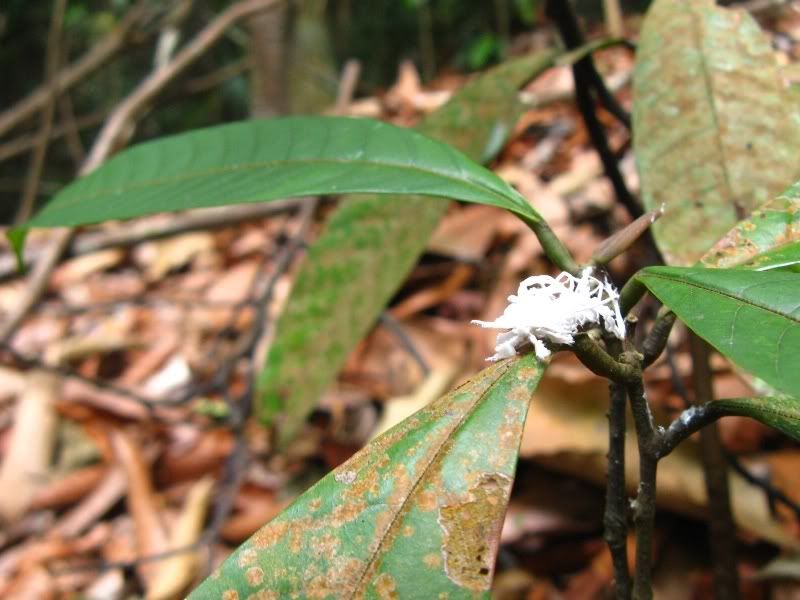 ___
___
One of the prettier insects that we bumped into on that particular day, the nymph of a hopper. This ball of white fluff is actually smaller than it's made out to be. The white, stringy threads are actually wax secretions to make the insect look bigger than it really is. =)
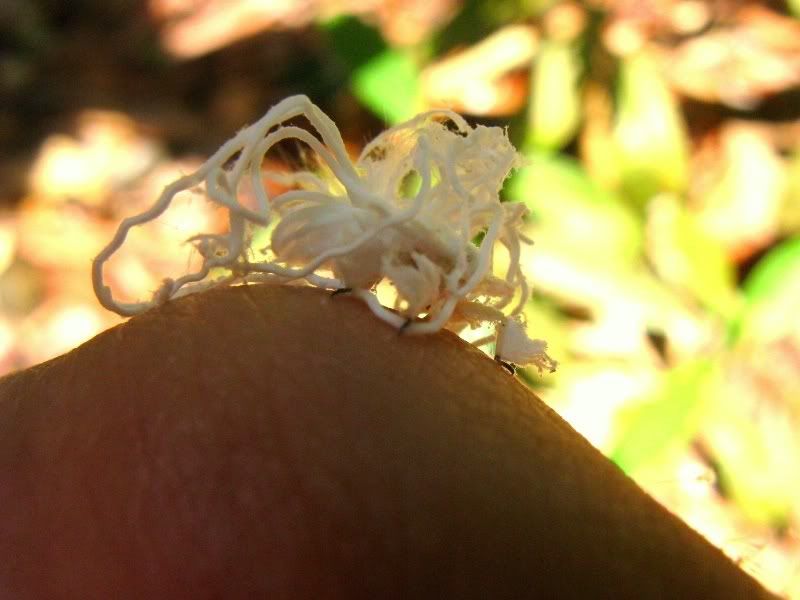 ___
___
(left): The right side of the insect.
(right): A frontal view of the insect. See its eyes peeking out? =)
 ___
___
A Baron Butterfly that was sweet enough to halt awhile for several poses. :)
 ___
___
And just as we were taking shots of the ant-mimicking spider, I suddenly spotted a peanut-looking insect that seemed to be clinging for its life on a slender stem. After some clarification, only did I know this bug is a weevil (or snout beetles as defined by the shape of their heads) ^^. Most weevils are damaging to crops but I am not sure about this wee guy right here though. Let's not give a dog a bad name and hang him shall we? :)
 ___
___
(left): And perching just above a lone outcrop is an assassin bug on the wait. So named because of their tendency to wait and then ambush their prey. If not handled carefully, they may bite and boy will it hurt [18]. *nods*
(right): An assassin bug in Kill Bill mode. With the yellow-black colouration, the bug certainly does resemble the Bride in Kill Bill 1. No? :)
(right): An assassin bug in Kill Bill mode. With the yellow-black colouration, the bug certainly does resemble the Bride in Kill Bill 1. No? :)
 ___
___
(left): And one of the more splendid moments of the day is a sighting of the Banded Woodpecker (Picus miniaceus). The picture isn't clear, but it was the still better than I expected seeing that the bird was approximately 3-4 meters away from me. ^^v
(right): A rock pigeon that was captured as I tried to shoot a photo of the lightning that was zapping just over the horizon.
All in all, it was a fantastic day. My spirits were simply bursting on my way back to hall. A big thank you to everyone who made my morning that day. =) (Non-humans included too.. ^___^)
(right): A rock pigeon that was captured as I tried to shoot a photo of the lightning that was zapping just over the horizon.
All in all, it was a fantastic day. My spirits were simply bursting on my way back to hall. A big thank you to everyone who made my morning that day. =) (Non-humans included too.. ^___^)
** My apologies for the previous mistakes, which has been clarified and rectified.
Thanks LK for the pointing out the errors! =)
Reference:
[1] http://en.wikipedia.org/wiki/Parkia_speciosa
[2] Tan, Hugh T. W. ; L. M. Chou, et al, "The Natural Heritage of Singapore", 2007.
[3] http://www.answers.com/topic/herbivory
[4] http://dictionary.reference.com/search?q=rhizo-&db=luna ; http://dictionary.reference.com/search?q=-phore
[5] http://www.naturia.per.sg/buloh/plants/palm_fishtail.htm
[6] Wayside Trees of Malaya, E.J.H.Corner (1988), Malayan Nature Society.
[7] http://www.forestexplorers.com/rengastree.shtml
[8] http://waynesword.palomar.edu/plmay99.htm
[9] http://tidechaser.blogspot.com/2008/04/bukit-timah-nature-reserve.html
[10] http://www.environment.gov.au/biodiversity/abrs/online-resources/glossaries/vascular/stiparr.html
[11] http://www.rimbundahan.org/environment/plant_lists/rubiaceae/index.htm
[12] http://www.forestry.sarawak.gov.my/forweb/research/tang.htm
[13] http://www.geocities.com/ahbloo/caesalp.html
[14] http://en.wikipedia.org/wiki/Ebony
[15] http://www.naturia.per.sg/buloh/inverts/argiope.htm
[16] http://www.ext.colostate.edu/pubs/insect/05512.html
[17] http://entomology.ifas.ufl.edu/fasulo/woodypest/scales.htm
[18] http://en.wikipedia.org/wiki/Reduviidae
